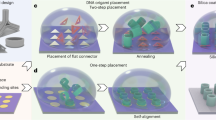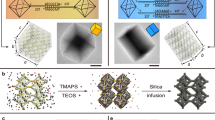Abstract
Artificial DNA nanostructures1,2 show promise for the organization of functional materials3,4 to create nanoelectronic5 or nano-optical devices. DNA origami, in which a long single strand of DNA is folded into a shape using shorter ‘staple strands’6, can display 6-nm-resolution patterns of binding sites, in principle allowing complex arrangements of carbon nanotubes, silicon nanowires, or quantum dots. However, DNA origami are synthesized in solution and uncontrolled deposition results in random arrangements; this makes it difficult to measure the properties of attached nanodevices or to integrate them with conventionally fabricated microcircuitry. Here we describe the use of electron-beam lithography and dry oxidative etching to create DNA origami-shaped binding sites on technologically useful materials, such as SiO2 and diamond-like carbon. In buffer with ∼100 mM MgCl2, DNA origami bind with high selectivity and good orientation: 70–95% of sites have individual origami aligned with an angular dispersion (±1 s.d.) as low as ±10° (on diamond-like carbon) or ±20° (on SiO2).
This is a preview of subscription content, access via your institution
Access options
Subscribe to this journal
Receive 12 print issues and online access
$259.00 per year
only $21.58 per issue
Buy this article
- Purchase on Springer Link
- Instant access to full article PDF
Prices may be subject to local taxes which are calculated during checkout




Similar content being viewed by others
References
Seeman, N. C. Nucleic-acid junctions and lattices. J. Theoret. Biol. 99, 237–247 (1982).
LaBean, T. H. & Li, H. Constructing novel materials with DNA. Nanotoday 2, 26–34 (2007).
Braun, E., Eichen, Y., Sivan, U. & Ben-Yoseph, G. DNA-templated assembly and electrode attachment of a conducting silver wire. Nature 391, 775–778 (1998).
Le, J. D. et al. DNA-templated self-assembly of metallic nanocomponent arrays on a surface. Nano Lett. 4, 2343–2347 (2004).
Kennen, K., Berman, R. S., Buchstan, E., Sivan, U. & Braun, E. DNA-templated carbon nanotube field effect transistor. Science 302, 1380–1382 (2003).
Rothemund, P. W. K. Folding DNA to create nanoscale shapes and patterns. Nature 440, 297–302 (2006).
International Technology Roadmap for Semiconductors, 2007 edition (http://www.itrs.net/Links/2007ITRS/Home2007.htm).
Zhang, L. et al. Assessment of chemically separated carbon nanotubes for nanoelectronics. J. Am. Chem. Soc. 130, 2686–2691 (2008).
Lu, W. & Lieber, C. M. Nanoelectronics from the bottom up. Nat. Mater. 6, 841–850 (2007).
Cui, Y. et al. Integration of colloidal nanocrystals into lithographically patterned devices. Nano Lett. 4, 1093–1098 (2004).
Malaquin, L., Kraus, T., Schmid, H., Delamarche, E. & Wolf, H. Controlled particle placement through convective and capillary assembly. Langmuir 23, 11513–11521 (2007).
Wang, Y. et al. Controlling the shape, orientation, and linkage of carbon nanotube features with nano affinity templates. Proc. Natl Acad. Sci. USA, 103, 2026–2031 (2006).
Seemann, L., Stemmer, A. & Naujoks, N. Local surface charges direct the deposition of carbon nanotubes and fullerenes into nanoscale patterns. Nano Lett. 7, 3007–3012 (2007).
Fan, Z. et al. Wafer-scale assembly of highly ordered semiconductor nanowire arrays by contact printing. Nano Lett. 8, 20–25 (2008).
Cheng, J. Y., Ross, C. A., Smith, H. I. & Thomas, E. L. Templated self-assembly of block copolymers: top-down helps bottom-up. Adv. Mater. 18, 2505–2521 (2006).
Zheng, J. et al. Two-dimensional nanoparticle arrays show the organizational power of robust DNA motifs. Nano Lett. 6, 1502–1504 (2006).
Losilla, N. S. et al. Sub-50 nm positioning of organic compounds onto silicon oxide patterns fabricated by local oxidation nanolithography. Nanotechnology 19, 455308 (2008).
Chi, P.-Y., Lin, H.-Y., Liu, C.-H. & Chen, C.-D. Generation of nano-scaled DNA patterns through electro-beam induced charge trapping. Nanotechnology 17, 4854–4858 (2006).
Tanaka, S., Taniguchi, M. & Kawai, T. Selective adsorption of DNA onto SiO2 surface in SiO2/SiH pattern. Jpn. J. Appl. Phys. 43, 7346–7349 (2004).
Djenizian, T., Balaur, E. & Schmuki, P. Direct immobilization of DNA on diamond-like carbon nanodots. Nanotechnology 17, 2004–2007 (2006).
Sarveswaran, K., Hu, W., Huber, P. W., Bernstein, G. H. & Lieberman, M. Deposition of DNA rafts on cationic SAMs on silicon [100]. Langmuir 22, 11279–11283 (2006).
Kuzyk, A., Yurke, B., Toppari, J. J., Linko, V. & To¨rma¨, P. Dielectrophoretic trapping of DNA origami. Small 4, 447–450 (2008).
Moreau, W. M. Semiconductor Lithography Principles, Practices and Materials (Plenum Press, 1998).
Ferrari, A. C. Diamond-like carbon for magnetic storage disks. Surf. Coat. Technol. 180, 190–206 (2004).
Druz, B. et al. Ion beam deposition of diamond-like carbon from an RF inductively coupled CH4-plasma source. Surf. Coat. Technol. 86–87, 708–714 (1996).
Pastŕe, D. et al. Anionic polyelectrolyte adsorption on mica mediated by multivalent cations: a solution to DNA imaging by atomic force microscopy under high ionic strength. Langmuir 22, 6651–6660 (2006).
Zhang, X. G. Electrochemistry of Silicon and its Oxide (Springer, 2001).
Ermakova, L. E., Sidorova, M. P. & Bogdanova, N. F. Influence of the structure of boundary layers and the nature of counterions on the position of the isoelectric point of silica surfaces. Colloid J. 68, 411–416 (2006).
Grosberg, A. Y., Nguyen, T. T. & Shklovskii, B. I. Colloquium: the physics of charge inversion in chemical and biological systems. Rev. Mod. Phys. 74, 329–345 (2002).
Lyklema, J. Overcharging, charge reversal: chemistry or physics? Colloids Surf. A 291, 3–12 (2006).
van der Heyden, F. H. J., Stein, D., Besteman, K., Lemay, S. G. & Dekker, C. Charge inversion at high ionic strength studied by streaming currents. Phys. Rev. Lett. 96, 224502 (2006).
Loewenstein, L. M. & Mertens, P. W. Adsorption of metal ions onto hydrophilic silicon surfaces from aqueous solution: effect of pH. J. Electrochem. Soc. 145, 2841–2847 (1998).
Szunerits, S. & Boukherroub, R. Different strategies for functionalization of diamond surfaces. J. Solid State Electrochem. 12, 1205–1218 (2008).
Hung, A. M. et al. Spatially-directed assembly of gold nanoparticles on lithographically patterned DNA origami. Nature Nanotech. (Submitted).
Acknowledgements
This work was supported by National Science Foundation grants CCF/NANO/EMT-0622254 and -0829951 and the Focus Center Research Program (FCRP). Center on Functional Engineered Nano Architectonics (FENA) Theme 2. P.W.K.R thanks Microsoft Corporation for support. The authors thank D. Miller for performing XPS measurements, B. Davis for optical lithography, D. Hoffman for sample preparation, and M. Sanchez, M. Hart and F. Houle for helpful discussions.
Author information
Authors and Affiliations
Contributions
All authors contributed significantly to the work presented in this paper.
Corresponding authors
Supplementary information
Supplementary information
Supplementary information (PDF 9659 kb)
Supplementary information
Supplementary movie (MOV 3249 kb)
Rights and permissions
About this article
Cite this article
Kershner, R., Bozano, L., Micheel, C. et al. Placement and orientation of individual DNA shapes on lithographically patterned surfaces. Nature Nanotech 4, 557–561 (2009). https://doi.org/10.1038/nnano.2009.220
Received:
Accepted:
Published:
Issue Date:
DOI: https://doi.org/10.1038/nnano.2009.220
This article is cited by
-
Nuclease resistance of DNA nanostructures
Nature Reviews Chemistry (2021)
-
DNA origami
Nature Reviews Methods Primers (2021)
-
Building machines with DNA molecules
Nature Reviews Genetics (2020)
-
Directional Assembly of Nanoparticles by DNA Shapes: Towards Designed Architectures and Functionality
Topics in Current Chemistry (2020)
-
A rotary plasmonic nanoclock
Nature Communications (2019)



